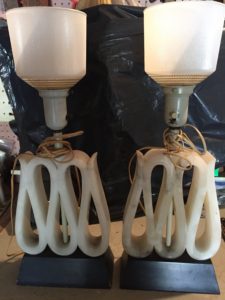 A pair of lamps I appraised at a Road Show in Pennsylvania made me think of Dorothy Draper and Billy Haines. In their hey-day, the mid 1930s through the 1940s, these two fabulous designers became known for Baroque Modernism. This is the exact opposite of the prevailing style called Minimalism today. The client wants to sell these lamps and asked if I remembered the pair. Yes, they stuck in my mind for a good reason. they exemplify Hollywood Regency.
A pair of lamps I appraised at a Road Show in Pennsylvania made me think of Dorothy Draper and Billy Haines. In their hey-day, the mid 1930s through the 1940s, these two fabulous designers became known for Baroque Modernism. This is the exact opposite of the prevailing style called Minimalism today. The client wants to sell these lamps and asked if I remembered the pair. Yes, they stuck in my mind for a good reason. they exemplify Hollywood Regency.
Some people love this look (I do!) called Hollywood Regency after the glamour days of the 1930-40s of big, colorful, dramatic, mirrored tall ceiling interior settings seen in the movies of that era. And the stars dressed right for these rooms, in satin boudoir gowns and smoking jackets. Considered a native Californian style, through the bloodline of Haines, himself a Hollywood silent film actor. Draper, an East Coast gal, also designed in this glamorous style. Haines did the homes of Joan Crawford and Jack Warner. In my opinion people still think of this look as sophisticated.
All the elements of Hollywood Regency
These lamps evoke a previous, Classical era (think Rome) with their use of white marble and elegant abstraction. The line of the lamps, bold and repetitive bring to mind Baroque era’s plasterwork interiors. They’re hand carved of a semi-precious material, the antithesis of mass-produced design, playful, light in color and design, but heavy in weight. As a matched pair, they speak of symmetry. All these elements brand them as Hollywood Regency from the 1940’s.
A trained eye recognizes Hollywood Regency as a mix of three previous styles in architecture and the decorative arts. First the Georgian look (English) of the 18th century. Then the Italianate, a style first ‘discovered’ when the Renaissance re-discovered Classical architecture (the Palladian style). Third the style borrows from French Rococo, designed for the wealthy in light playful colors and shapes, a style that favored a whiplash line.
Hollywood Regency Designers
The rich and famous hired designers like Draper and Haines for their “integrated interiors.” This meant they designed the wallpapers, the fabrics, the scale of the rooms and placement of the big windows and the mirrors. They found the antiques, rugs, and designed and commissioned the light fixtures and the furniture as well. Haines became known for making his own furniture, one-off pieces, for his Hollywood clients.
Draper probably would’ve loved these lamps because she loved to contrast white with black. Her signature look was the black and white tiled floor for the foyer. In contrast to this starkness, she hung yards of big bold colorful chintz fabric draperies and crafted whimsical but huge birdcage chandeliers. The style filtered down to the American middle class, and my grandmother, a fan, threw chintz on the windows and on the big comfy easy chairs.
I wish I’d been at the opening party for Draper’s masterpiece of design, the Greenbrier Hotel in White Sulphur Springs, West Virginia. Draper used 45,000 yards of fabric, 15,000 rolls of wallpaper, and 40,000 gallons of paint. Like me, she loved pink paint (my living room is pink) because it created a nice glow on older faces. She painted the ballroom at the Greenbrier pink. She loved pink with stripes and cabbage rose chintz, for both draperies and seating furniture. Often that seating furniture appeared outrageous in glass or painted white frames, set in a room with metallic accents and mirrored tables and chests.
Fabulous!
Imagine these lamps in a room in the 1940’s surrounded by colors such as pink, turquoise, seafoam, yellow, and of course black and white. Picture a high ceiling mirrored room with long tall windows. The occasional animal print pouf added fun. Visitors to a room like this often hoped they packed their silk dressing gowns and their silver martini shakers.
People, like me, still love this style, although in my case, I stay away from floral prints and instead love pink velvet. For that reason my partner calls my brand of Hollywood Regency “Early Brothel Regency.” I told my client in Pennsylvania to hope for $800 for her pair of marble 1940s lamps. Here in California, the birthplace of the style, they might fetch $1,000.
Another column where I learned about a style I’d never heard of! Hollywood Regency – who knew?!?! Of of course You Do!